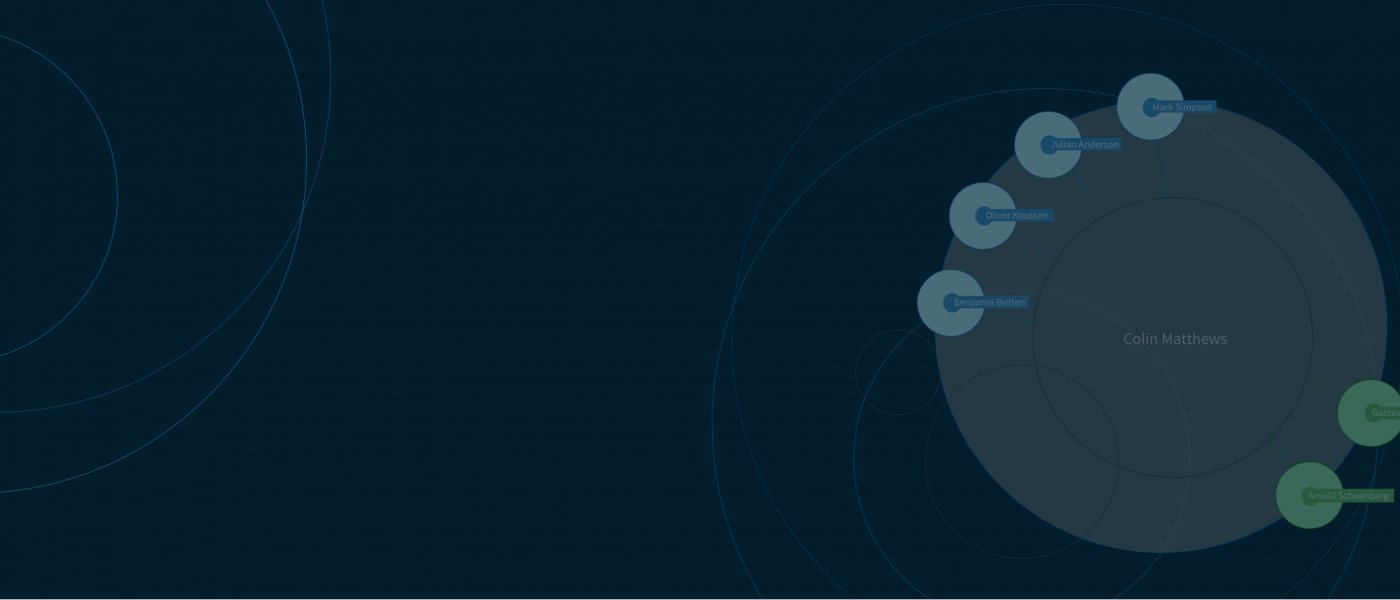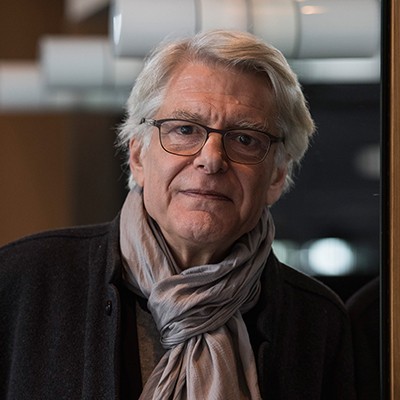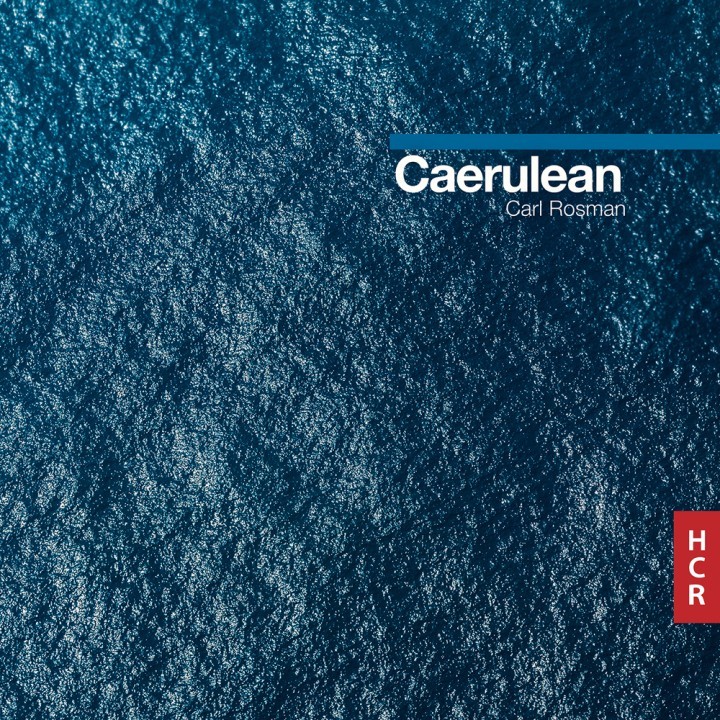Georges Aperghis
A Greek composer born in Athens in 1945, he has lived and worked in Paris since 1963.
In 1971, after a few instrumental pieces more or less inspired by serial techniques, he composes his first musical play La tragique histoire du nécromancien Hiéronimo et de son miroir. This piece is at the root of much of his future investigations into the relationships between music and text, between music and stage. Thus, he takes part in the great adventure of musical theater that begun in France at the Festival d’Avignon.
In 1976, with the founding of ATEM (Atelier Théâtre et Musique), he reinvents his approach to composition with a new art-form inspired by everyday life and social issues transposed into an often absurd and poetic world, in which musicians, singers, actors, and multimedia artists meet on a equal footing (La bouteille à la mer, 1976; Conversations, 1985; Sextuor, 1993; Commentaires, 1996)
After leaving ATEM in 1997, he goes on writing musical plays (Machinations, 2000; Paysage sous surveillance, 2002; Le petit chaperon rouge, 2003; Luna Park, 2011).
His concert music includes a large series of instrument or vocal solo pieces (among them is his masterpiece Récitations, 1978), introducing theatrical elements here and there, sometimes purely gestural. His chamber music, either orchestral, vocal, or instrumental, is rich of many pieces composed for a wide variety of performing ensembles. In these, he does not give up his taste for experimentation, nor for a certain kind of provocation (Die Wände haben Ohren, for large orchestra, 1972), but unlike musical theater, nothing is intentionally stage-oriented, all is composition-driven.
His opera works, a third domain of activity, may be considered a synthesis of his musical theater and concert music; here, the text is the unifying and decisive element, and the singing voice is the main vector of expression. Georges Aperghis has composed seven lyrical works, including Pandemonium (1973) inspired by Jules Vernes’ writings, Liebestod (1981) after a letter from Brentano to Goethe, Tristes tropiques (1996) after Levi-Strauss, Les Boulingrin (2010) after Georges Courteline.
Indeed, since the early 2000s, classifying Georges Aperghis’s works in three distinct domains is more confusing than ever because of their very nature. Die Hamletmaschine (2001), an oratorio based on Heiner Muller’s work; Dark Side (2004), a "monodrama" based on Aeschylus’ Oresteia; Avis de tempête (2004), an opera; perhaps even Wölfli Kantata (2006), a cantata after Adolf Wölfli’s writings; or Happiness Daily (2009), for soprano, mezzo-soprano and ensemble; all of them challenge the issues of drama, of performance, of staging, and they illustrate the freedom with which Georges Aperghis plays on classification and genre, in the performing arts as well as the theater.
A prolific composer with a never-ending inventiveness, Georges Aperghis is building a very personal corpus of works, serious and humorous at the same time, rooted in tradition as well as free of institutional constraints. Knowledgeably opening up unexpected horizons of vitality and ease for his performers, he skillfully reconciles the sound and the visual, as much as he broaches issues embedded in the tragic or derisory aspects of his time.
In October 2011, Georges Aperghis received the Mauricio Kagel’s Prize.
A Greek composer born in Athens in 1945, he has lived and worked in Paris since 1963.
In 1971, after a few instrumental pieces more or less inspired by serial techniques, he composes his first musical play La tragique histoire du nécromancien Hiéronimo et de son miroir. This piece is at the root of much of his future investigations into the relationships between music and text, between music and stage. Thus, he takes part in the great adventure of musical theater that begun in France at the Festival d’Avignon.
In 1976, with the founding of ATEM (Atelier Théâtre et Musique), he reinvents his approach to composition with a new art-form inspired by everyday life and social issues transposed into an often absurd and poetic world, in which musicians, singers, actors, and multimedia artists meet on a equal footing (La bouteille à la mer, 1976; Conversations, 1985; Sextuor, 1993; Commentaires, 1996)
After leaving ATEM in 1997, he goes on writing musical plays (Machinations, 2000; Paysage sous surveillance, 2002; Le petit chaperon rouge, 2003; Luna Park, 2011).
His concert music includes a large series of instrument or vocal solo pieces (among them is his masterpiece Récitations, 1978), introducing theatrical elements here and there, sometimes purely gestural. His chamber music, either orchestral, vocal, or instrumental, is rich of many pieces composed for a wide variety of performing ensembles. In these, he does not give up his taste for experimentation, nor for a certain kind of provocation (Die Wände haben Ohren, for large orchestra, 1972), but unlike musical theater, nothing is intentionally stage-oriented, all is composition-driven.
His opera works, a third domain of activity, may be considered a synthesis of his musical theater and concert music; here, the text is the unifying and decisive element, and the singing voice is the main vector of expression. Georges Aperghis has composed seven lyrical works, including Pandemonium (1973) inspired by Jules Vernes’ writings, Liebestod (1981) after a letter from Brentano to Goethe, Tristes tropiques (1996) after Levi-Strauss, Les Boulingrin (2010) after Georges Courteline.
Indeed, since the early 2000s, classifying Georges Aperghis’s works in three distinct domains is more confusing than ever because of their very nature. Die Hamletmaschine (2001), an oratorio based on Heiner Muller’s work; Dark Side (2004), a "monodrama" based on Aeschylus’ Oresteia; Avis de tempête (2004), an opera; perhaps even Wölfli Kantata (2006), a cantata after Adolf Wölfli’s writings; or Happiness Daily (2009), for soprano, mezzo-soprano and ensemble; all of them challenge the issues of drama, of performance, of staging, and they illustrate the freedom with which Georges Aperghis plays on classification and genre, in the performing arts as well as the theater.
A prolific composer with a never-ending inventiveness, Georges Aperghis is building a very personal corpus of works, serious and humorous at the same time, rooted in tradition as well as free of institutional constraints. Knowledgeably opening up unexpected horizons of vitality and ease for his performers, he skillfully reconciles the sound and the visual, as much as he broaches issues embedded in the tragic or derisory aspects of his time.
In October 2011, Georges Aperghis received the Mauricio Kagel’s Prize.
Compilations with this composer
CompilationsExternal Links
Music Map
Discover more about the classical music of today with NMC's Music Map, and exciting and educational online tool which enables you to see and hear the connections between composers, their teachers, pupils, influences and their works.
Music Map

